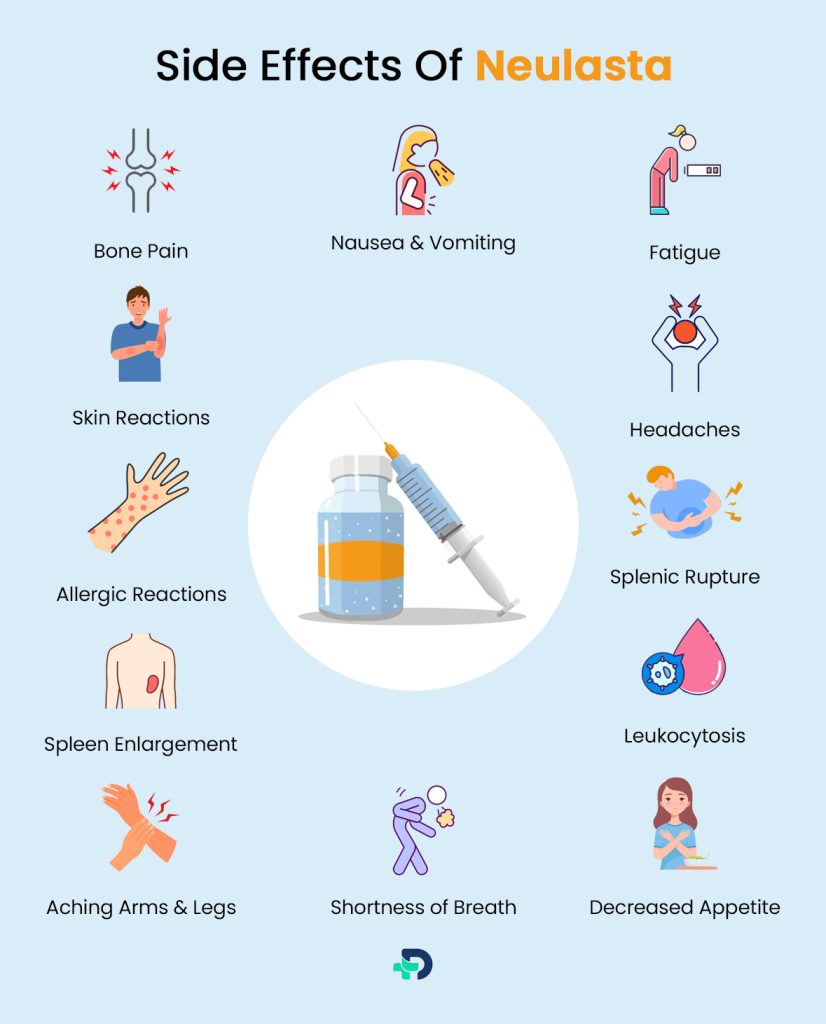Neulasta: Empowering Cancer Patients Through Innovative Support

- Neulasta
- 18 Sep 2023
Introduction
Neulasta for Cancer
In the ever-evolving landscape of modern medicine, breakthroughs continue to emerge that transform the way we approach health and wellbeing. Among these remarkable advancements, Neulasta has emerged as a crucial tool in the fight against cancer, providing unprecedented support to patients undergoing chemotherapy. This article delves into the multifaceted world of Neulasta, exploring its origins, mechanism of action, therapeutic applications, potential side effects, and the hope it brings to countless individuals battling cancer.

Origin
Unveiling the marvel: Neulasta’s origin
- Neulasta, a brand name for the generic drug pegfilgrastim, stands as a testament to the power of scientific innovation.
- Peg filgrastim is classified as a colony-stimulating factor (CSF), belonging to a class of biopharmaceuticals that revolutionize how the human body fights infections during cancer treatment.
- Developed by Amgen, a leading biotechnology company, Neulasta was approved by the U.S. Food and Drug Administration (FDA) in 2002 as a remarkable breakthrough in cancer care.1 Origin | Researched based study from Neulasta
Mechanism
How does Neulasta work?
- At the heart of Neulasta’s efficacy lies its ability to stimulate the bone marrow to produce white blood cells known as neutrophils.
- These neutrophils play a very important role in body’s defenses against various types of infections.
- The drug Neulasta has an active component known as pegfilgratism which is a synthetic analogue of the naturally occurring granulocyte colony stimulating factor.
- This protein binds to specific receptors on the surface of cells in the bone marrow, initiating a cascade of signals that amplify the production and release of neutrophils into the bloodstream.
Applications
Applications of Neulasta
What is Neulasta used for?
- Prevents Neutropenia
- Safeguards against infections
- Enhances chemotherapy tolerance
- Enables aggressive treatment
- Supports Recovery
- Boosts Patient confidence
- Minimizes Treatment Disruptions
- Adapts to Individual Needs
- Enhances Quality of Life
- Paves the Way for Successful Outcomes
Counteracts Neutropenia
- Description: Neutropenia, a common side effect of chemotherapy, involves a significant drop in neutrophil levels – crucial white blood cells responsible for fighting infections.
- Therapeutic Use: Neulasta is administered to prevent neutropenia. By stimulating the bone marrow to produce more neutrophils, it bolsters the immune system and reduces vulnerability to infections.
Safeguards Against Infections
- Description: Chemotherapy weakens the immune system, making patients susceptible to infections that could disrupt treatment schedules and compromise health.
- Therapeutic Use: Neulasta’s ability to maintain healthy neutrophil levels acts as a protective shield, reducing the risk of infections and enabling uninterrupted cancer treatment.
Enhances Chemotherapy Tolerance
- Description: Chemotherapy’s side effects can impact patients’ well-being and quality of life, potentially leading to treatment interruptions.
- Therapeutic Use: By reducing the risk of infections and their associated complications, Neulasta helps patients tolerate chemotherapy more effectively, enhancing their overall treatment experience.
Enables Aggressive Treatment Strategies
- Description: Some cancer cases require intensive chemotherapy regimens that can lead to severe neutropenia.
- Therapeutic Use: Neulasta enables oncologists to pursue aggressive treatment approaches by mitigating the risk of neutropenia, allowing for optimal treatment doses and intensities.
Supports Oncological Recovery
- Description: Cancer patients often face a challenging journey of recovery, and their weakened immune systems can hinder healing.
- Therapeutic Use: Neulasta’s immune-boosting effects aid patients in recovering from cancer treatments, reducing the likelihood of infections that could prolong the recovery process.
Fosters Patient Confidence
- Description: Coping with cancer and its treatments can be emotionally taxing. Fear of infections adds to patients’ stress.
- Therapeutic Use: Neulasta’s preventive actions offer patients peace of mind, allowing them to focus on their healing journey without constant worry about infections.
Minimizes Treatment Disruptions
- Description: Infections can lead to treatment delays or modifications, impacting treatment effectiveness.
- Therapeutic Use: Neulasta’s ability to reduce infection risk contributes to treatment consistency, optimizing the potential for positive outcomes.
Adapts to Individual Needs
- Description: Each patient’s response to chemotherapy varies, necessitating tailored approaches to support and care.
- Therapeutic Use: Neulasta’s flexibility in dosing and administration allows healthcare providers to adapt treatment to each patient’s specific needs and circumstances.
Enhances Quality of Life
- Description: Maintaining a good quality of life during cancer treatment is paramount for overall well-being.
- Therapeutic Use: Neulasta’s role in reducing the burden of infections and related complications has been a proven cause in improving the overall quality of life in a large group of cancer patients.
Paves the Way for Successful Outcomes
- Description: Successful cancer treatment outcomes depend on a range of factors, including immune system support.
- Therapeutic Use: By optimizing the immune system’s ability to ward off infections, Neulasta contributes to creating a favorable environment for successful treatment outcomes. 2 Applications | Researched based study from National Institutes of Health
Side Effects

Side effects of Neulasta
What are the side effects of Neulasta and How to deal with Neulasta side effects?
- Bone pain
- Fatigue
- Skin Reactions (Skin redness, itchy skin)
- Headaches
- Allergic Reactions
- Splenic Rupture
- Spleen Enlargement
- Leukocytosis (Increase in white blood cells)
- Leg and arm pain
- Decreased appetite
- Flu like symptoms (Fever and Muscle pain)
- Nausea and Vomiting
- Shortness of Breath
Bone Pain
- Description: One of the most commonly associated side effect of the drug is bone pain and bone tenderness. Patients often describe it as an aching or soreness in their bones and joints.
- Management: Various over the counter medications such as pain killers can help with the pain. However, it is advised to consult with your health care provider before starting these medications.
Fatigue
- Description: Some patients may experience increased fatigue or general tiredness after Neulasta administration.
- Management: Prioritizing rest, staying hydrated, and maintaining a balanced diet can help alleviate fatigue. Consult your healthcare provider if fatigue becomes persistent or severe.
Skin Reactions
- Description: Localized skin reactions, such as redness which can either be generalized or in patches along with swelling and an itchy feeling.
- Management: Inform your doctor of these side effects immediately. Mild reactions typically subside on their own, but severe or persistent reactions should be evaluated by a healthcare professional.
Headaches
- Description: Headaches are a potential side effect following Neulasta administration.
- Management: Over-the-counter pain relievers and staying hydrated can often help alleviate headaches. If they are persisting, it is highly advised to consult your doctor.
Allergic Reactions
- Description: Although rare, severe allergic reactions can occur, presenting as difficulty breathing, rash, hives, swelling, or dizziness.
- Action: Seek immediate medical attention if you experience any signs of an allergic reaction after Neulasta administration.
Splenic Rupture
- Description: In rare cases, Neulasta has been associated with the risk of splenic rupture, which can cause abdominal pain or discomfort.
- Action: If you experience sudden or severe abdominal pain, seek medical attention promptly.
Spleen Enlargement
- Description: Neulasta can cause temporary enlargement of the spleen, leading to discomfort in the upper left abdomen.
- Action: If you experience persistent or severe abdominal discomfort, consult your healthcare provider.
Leukocytosis
- Description: Neulasta’s stimulation of white blood cell production can lead to an increase in white blood cell counts, a condition called leukocytosis.
- Management: Monitoring by your healthcare provider is crucial to ensure white blood cell counts remain within safe limits.
Aching Arms and Legs
- Description: Some patients may experience aching in their arms and legs following Neulasta administration.
- Management: Rest and gentle movements can often help alleviate this discomfort. If aches persist or worsen, consult your healthcare provider.
Decreased Appetite
- Description: Neulasta can sometimes lead to a temporary decrease in appetite.
- Management: Focus on eating small, nutrient-rich meals and staying hydrated. If appetite loss persists, discuss with your healthcare provider.
Flu-Like Symptoms
- Description: Patients may experience flu-like symptoms which include chills, with fluctuating fever and myalgia or muscle pain.
- Management: Adequate hydration, rest, and over-the-counter medications can help manage these symptoms.
Nausea and Vomiting
- Description: Nausea and vomiting are potential side effects of Neulasta.
- Management: Staying hydrated and consuming bland, easy-to-digest foods can help alleviate nausea. Consult your healthcare provider if vomiting becomes severe or persistent.
Shortness of Breath
- Description: Although very rare, neulasta can cause breathing difficulties.
- Action: Seek immediate medical attention if you experience any breathing difficulties after Neulasta administration. 3 Side Effects| Researched based study from National Cancer Institute
Administration
Indications & Administration of Neulasta
Neulasta finds its role in cancer care as an essential adjunct to chemotherapy.
- It is indicated for patients that are undergoing chemotherapy with high risk of developing extreme cases of neutropenia.
- The administration of Neulasta typically involves a single subcutaneous injection, scheduled to coincide with the chemotherapy cycle.
- The drug’s extended half-life ensures a sustained impact, reducing the frequency of injections required and enhancing patient convenience.
Contraindications
Contraindications for Neulasta
While Neulasta has demonstrated its safety and efficacy in a wide range of patients, certain situations warrant caution or avoidance.
- Individuals with a known hypersensitivity to pegfilgrastim or its components should not receive Neulasta.
- Furthermore, careful consideration is needed for patients with specific types of cancer, such as myeloid malignancies, to ensure that the benefits of Neulasta outweigh any potential risks.
Dosing
Dosing of Neulasta
Why give Neulasta 24 hours after chemo?
The timing of Neulasta administration is carefully orchestrated to maximize its effectiveness in bolstering the immune system without interfering with chemotherapy schedules. Neulasta is typically administered approximately 24 hours after chemotherapy. This strategic window allows for several key factors to align:
Bone Marrow Stimulation:
- Neulasta needs time to stimulate the bone marrow to produce a surge of neutrophils.
- Administering it post-chemotherapy ensures that the neutrophil production is synchronized with the anticipated drop in neutrophil levels caused by the chemotherapy.
Reduced Interference:
- Administering Neulasta after chemotherapy minimizes any potential interference with the chemotherapy’s impact on cancer cells.
- This separation helps maintain the therapeutic efficacy of both interventions.
Mitigating Neutropenia:
- By introducing Neulasta during the post-chemotherapy phase, the risk of neutropenia – and consequently, infection susceptibility – is significantly reduced.
- This is especially crucial during the period when the body is most vulnerable due to suppressed neutrophil levels.4 Dosing| Researched based study from Medline Plus
FAQs
Frequently Asked Questions about Neulasta
Q: Can Neulasta replace traditional infection prevention measures during chemotherapy?
A: Neulasta significantly reduces the risk of infections, but patients should still adhere to recommended precautions, as it does not eliminate the possibility entirely.
Q: Can Neulasta be self-administered at home?
A: While Neulasta injections are often administered by healthcare professionals, some patients receive training to self-administer the drug under appropriate supervision.
Q: Does Neulasta have any long-term effects?
A: Neulasta’s focus is on short-term support during chemotherapy, making long-term effects uncommon due to its limited duration of action.
Bottom Line
Impact & Promise of Neulasta
Neulasta has redefined the landscape of cancer care by providing an invaluable tool to safeguard patients undergoing chemotherapy. By bolstering the immune system’s defenses, this remarkable drug empowers individuals to face their battle against cancer with renewed strength and hope. The collaborative efforts of researchers, healthcare providers, and patients continue to shape the trajectory of Neulasta’s impact, with ongoing research aimed at refining its applications and optimizing patient outcomes.
Any feedback on this article?
 This Articles content was accurate
This Articles content was accurate Very Informative Article
Very Informative Article I have a question or a comment
I have a question or a comment
 This article contains inaccurate content
This article contains inaccurate content This article was not helpful
This article was not helpful I have a question or a comment
I have a question or a comment
We appreciate your helpful feedback!
Checkout our social pages
References
-
Neulasta
Origin
-
National Institutes of Health
Applications
-
National Cancer Institute
Side Effects
-
Medline plus
Dosing





































